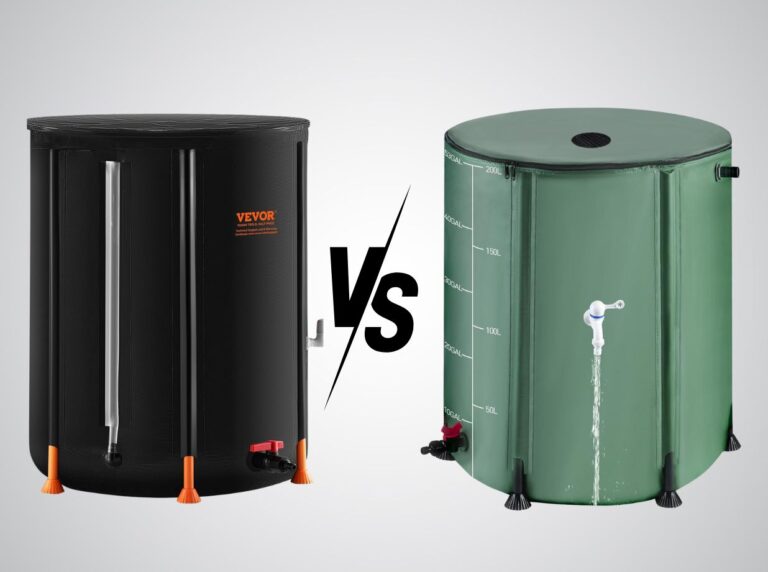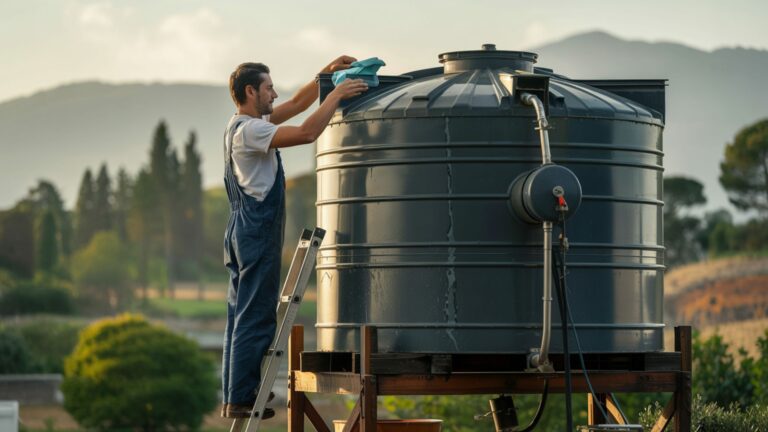How to Prevent Algae & Bacteria Growth in Your Rain Barrel
Did you know your rain barrel could be a hidden source of contamination for your garden? Algae and bacteria in stored rainwater can harm plants and lower water quality. They can also shorten your barrel’s lifespan. This article shows you how to keep your system clean and efficient.
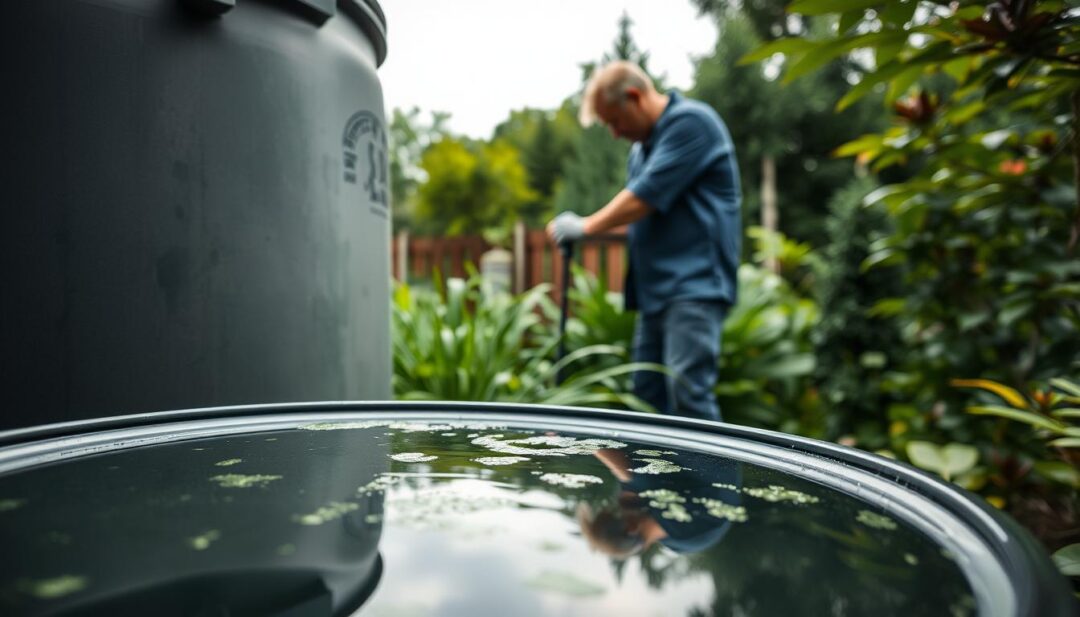
Key Takeaways
- Proper rain barrel maintenance prevents algae and bacteria from harming plants and water quality.
- Strategic design choices, like placement and seals, block contamination at the source.
- Regular cleaning routines are critical to removing growth before it spreads.
- Natural and chemical treatments offer balanced solutions for ongoing control.
- Seasonal care ensures your system stays functional year-round.
Rain barrels save water but need care to stay safe. This guide teaches you to prevent algae and bacteria growth. Learn how to protect your garden, extend equipment life, and keep water clean for irrigation.
Understanding Why Algae and Bacteria Develop in Rain Barrels
Rain barrels attract algae and bacteria because of their environment. These microorganisms thrive in warm, moist conditions common in stored water. Learning their growth triggers helps in applying effective preventing algae growth and avoiding bacteria in rain barrels.
The Science Behind Algae Formation
Algae need sunlight and nutrients to grow. When rainwater collects organic debris like leaves or dust, it provides the nitrogen and phosphorus they need. Photosynthesis fuels their spread, turning clear barrels into breeding grounds.
“Standing water in open containers creates perfect algae habitats,” warns the EPA. “Shade and reduced nutrients are key to control.”
Common Types of Bacteria Found in Rain Barrels
- Coliform bacteria: Enter via runoff from bird droppings or contaminated surfaces
- Legionella: Thrives in warm water, posing health risks if inhaled
- Decomposers: Break down organic matter, releasing odors and toxins
Environmental Factors That Accelerate Growth
Three conditions boost microorganism growth:
- Temperature: Warm summer weather speeds reproduction rates
- Sunlight exposure: Direct light triggers algae blooms
- Stagnation: Still water lacks oxygen needed to inhibit growth
Organic matter from rooftops acts as fuel, feeding both algae and bacteria continuously.
The Risks of Contaminated Rain Barrel Water
Contaminated rainwater can be dangerous for gardens, our health, and the environment. Algae and bacteria grow in untreated barrels. They release toxins that harm plants and upset soil balance.
| Risk Category | Effects | Prevention Tips |
|---|---|---|
| Plant Health | Plant diseases, nutrient imbalances, clogged irrigation systems | Regular cleaning and proper screening during rain barrel maintenance |
| Human Health | Skin irritation, respiratory issues from aerosolized microbes | Wear gloves and use tips for rain barrel care to minimize exposure |
| Economic Costs | Destroyed crops, costly system replacements | Adopt routine rain barrel maintenance to avoid repairs |
| Environmental Impact | Contamination of nearby waterways | Install overflow controls and follow tips for rain barrel care |
Ignoring these risks can cause long-term damage. Contaminated overflow can harm local wildlife. Regular checks and proper storage practices protect our investments and health. By focusing on rain barrel maintenance, we keep water safe for plants and people.
Essential Rain Barrel Design Features for Preventing Contamination
Choosing the right design is key to keeping rain barrels clean. The right placement, tight seals, and good drainage systems keep water pure. These features are crucial for a rain barrel’s long life and follow the best tips for rain barrel care.
Optimal Placement of Your Rain Barrel
Find a spot that gets some sun but not too much. Avoid areas with lots of leaves or branches. Make sure the ground is stable and the barrel is off the ground.
Gravel under the barrel helps with drainage. It also makes it easier to get to the barrel.
The Importance of Proper Sealing and Screening
- Put a 1/16-inch mesh screen over all openings to keep out bugs and leaves.
- Use rubber gaskets for lids to keep moisture and pests out.
- Make sure overflow pipes slope down to prevent water from flowing back up.
Drainage Considerations for Healthier Water
Good drainage stops water from standing and keeps it clean. Use first-flush diverters to get rid of the first 5–10 gallons of water. This water often has roof debris.
Position spigots 2 inches above the barrel’s bottom. This ensures water drains fully when you use it. Add sediment traps at the bottom to catch debris before it gets into the water.
How to Prevent Algae and Bacteria Growth in Your Rain Barrel
Keeping your rain barrel clean is key. It needs regular care and smart planning. Here are three main steps to stop bacteria and algae.
Regular Cleaning Routines
Here’s a cleaning schedule to keep your barrel clean:
- Monthly inspections: Look for debris, clean the inlet screens, and scrub the inside with a stiff brush.
- Quarterly deep cleaning: Use vinegar to disinfect, rinse well, and let it dry completely.
- Annual overhaul: Take apart the barrel, clean each part, and check the seals for damage.
You’ll need rubber gloves, non-toxic brushes, white vinegar, and a hose. Gloves protect you from dirty water.
Sunlight Management Techniques
Block sunlight to stop microbes from growing with these tips:
- Use opaque, UV-blocking covers to wrap barrels.
- Paint the outside with dark, safe paint to soak up light.
- Place barrels under trees or structures for natural shade.
Water Circulation Strategies
Keep water moving to avoid stagnation:
- Put in a small submersible pump to move water daily.
- Use the stored water often to keep it fresh.
- Change how often you use it based on the weather—more in humid areas.
By following these steps, you’ll have a system that controls bacteria growth in rain barrels and keeps water clean all year.
Natural Solutions for Controlling Microorganism Growth
There are natural ways to prevent algae in rain barrels without using chemicals. Here are some eco-friendly methods to keep your water clean and safe for plants:
- Apple Cider Vinegar: Add 1 oz of unpasteurized ACV per 10 gallons of water weekly. Shake well before use to inhibit microbial growth.
- Hydrogen Peroxide: Use 3% food-grade solution diluted 1:16 with water. Add ¼ cup per 50 gallons monthly for safe irrigation.
- Barley Straw: Place a small bale in the barrel; as it decomposes, it releases compounds that suppress algae naturally.
- Plant Extracts: Mix 5-10 drops of grapefruit seed extract or tea tree oil per gallon. Stir thoroughly and apply every two weeks.
For filtration, use activated charcoal filters to absorb impurities. Constructed wetlands beside larger systems can also purify water through natural processes. Always test diluted solutions first on plants to avoid damage.
Using sunlight (preventing algae growth) with these additives makes your efforts more effective. Natural solutions might need more upkeep than chemicals. But they are safe for gardens and ecosystems.
Chemical Treatment Options: When and How to Use Them
Chemical treatments are a last resort when natural methods don’t work. They offer strong control but must be used safely and responsibly. This ensures the water in your rain barrels stays clean.
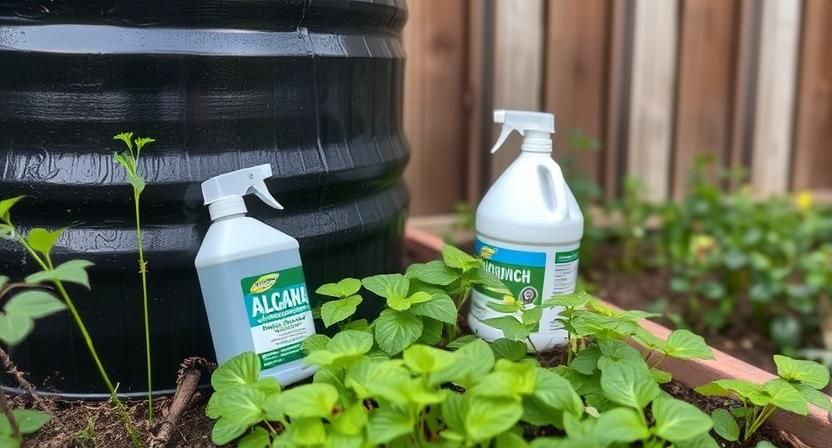
Safe Additives for Garden Water
Look for additives that are gentle on the environment:
- Calcium hypochlorite (e.g., Pool Shock): dilute to 1 ppm for algae control
- Food-grade hydrogen peroxide (3%) for periodic disinfection
- Commercial algaecides with EPA approval for rainwater systems
Proper Dosing Guidelines
- Calculate dosage: Use 1 gallon of chlorine solution per 50 gallons of water
- Test with water strips after treatment to confirm effectiveness
- Reapply only when algae resurfaces, avoiding routine use
Environmental Considerations
Chemical runoff must be minimized to protect local ecosystems and soil health.
Choose biodegradable options and follow EPA guidelines. This helps protect beneficial insects and aquatic life. Always check product labels for plant and wildlife safety.
Wear gloves and store chemicals securely. Try non-chemical methods first to keep your rain barrels clean for the long term.
Seasonal Rain Barrel Maintenance Best Practices
Rain barrel care changes with the seasons. Follow these tips for keeping your barrel clean all year. This way, you’ll always have good water.
“Regular seasonal adjustments are key to maintaining a clean and functional system year-round.” – National Garden Bureau
Spring Preparation Steps
Start spring by checking your barrel for damage or dirt. Then, flush it out to get rid of old water. Use a mix of bleach and water to clean it well. Keep your tools dry to stop rust.
- Check for structural damage
- Flush and sanitize containers
- Test overflow drains
Summer Vigilance Techniques
Keep an eye on your barrel’s water level every week in summer. Use a floating valve to block sunlight. After big rains, remove debris and check the water’s pH. Don’t fill it too much to avoid too many nutrients.
Fall and Winter Storage Guidelines
Empty your barrel before it gets cold. Use a siphon pump to get rid of any leftover water. Store it upside-down on blocks to stop water from pooling. Use a food-grade silicone spray to protect seals in winter.
- Drain barrels fully by November
- Store in a frost-free location
- Clean lids with a vinegar solution
By following these seasonal tips, your rain barrel will stay safe. Regular checks and care help it last longer and keep the water clean.
Troubleshooting Existing Algae and Bacteria Problems
Seeing algae or bad smells means you need to act fast to controlling bacteria growth in rain barrels. First, check if the water is clear. Look for greenish colors or floating stuff. If it feels slimy or smells musty, bacteria might be growing too much.
Use a pH test kit to see if the water is off balance. A reading below 6 or above 8 means it’s too contaminated.
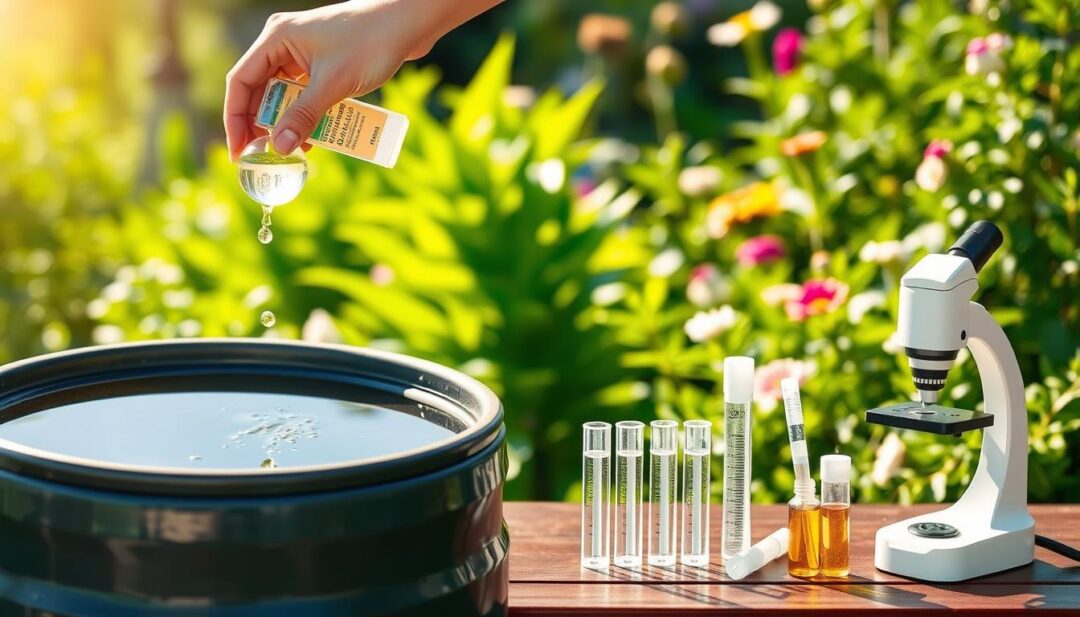
- Start by removing algae manually. Use a stiff brush and rinse well.
- If algae keeps coming back, mix ¼ cup of hydrogen peroxide with each gallon of water. Let it soak for 30 minutes before cleaning.
- For really tough cases, you might need to flush the whole system. Drain the water, then clean all surfaces with a mix of 1 part bleach to 10 parts water. Rinse well after.
To save water that’s been contaminated, filter it through a sediment filter and then a UV sterilizer. This way, you can still use the water. If there are still bad smells, add 1 teaspoon of activated carbon for every 5 gallons of water.
“Biofilm needs a good scrubbing—use a sponge to clean out all hidden spots.”
After fixing the problem, make sure to avoiding bacteria in rain barrels by putting back fine mesh screens. Also, check the barrel every month. Keep an eye on pH levels weekly when it’s growing fast. Make sure sunlight can’t get in and keep air moving around the barrel base.
Conclusion: Ensuring Long-Term Rain Barrel Health and Efficiency
Keeping a rain barrel clean is all about regular care and smart design. It’s important to clean it often and place it in a spot that doesn’t get too much sun. These tips for rain barrel care help keep the water safe for plants and save money on repairs.
Using natural methods like barley straw to stop algae, along with occasional chemicals, is a good mix. Regular checks and good drainage stop water from getting stuck. This is crucial for using your rain barrel for a long time.
Changing your approach with the seasons and fixing problems early can make your system last longer. New technologies like UV filters and sensors make it easier to keep an eye on things. They help keep the water quality high without a lot of work.
Creating a maintenance plan that fits your local weather and how you use your barrel is essential. Use the checklist to make a routine. Sticking to these steps will make your rain barrel last longer and help the environment. It’s better to prevent problems than to fix them after they happen.
Frequently Asked Questions
How can I prevent algae growth in my rain barrel?
To stop algae in your rain barrel, clean it often. Also, limit sunlight and use dark barrels or covers. Keep the water moving and clean it seasonally to keep it fresh.
What are the signs of bacteria contamination in rain barrels?
Look out for odd smells, cloudy water, and slimy stuff. Test the water often if you see these signs.
How often should I clean my rain barrel?
Clean your barrel monthly and do a deep clean every three months. An annual deep clean is also key to keep it clean.
Are there natural ways to control bacteria in my rain barrel?
Yes, use apple cider vinegar, hydrogen peroxide, or barley straw extracts. These natural methods can stop harmful bacteria without harming your garden.
What is the best way to handle a contaminated rain barrel?
First, figure out what’s wrong. If it’s algae or bacteria, remove it and clean it well. Use filters to save water instead of throwing it away.
How can I ensure my rain barrel remains clean during warmer months?
In warmer months, watch it more closely. Use covers and shade to block sunlight. Also, use the water often to prevent it from getting stale.
What drainage considerations should I take into account for my rain barrel?
Make sure your barrel drains well to avoid standing water. Use first-flush diverters and check spigot placement to avoid sediment.
Can chemicals be used safely in rain barrels?
Yes, but only safe ones like calcium hypochlorite or hydrogen peroxide. Always follow the instructions to protect plants and the environment.
Why are seasonal maintenance practices important for rain barrels?
Seasonal care tackles each season’s challenges. It prepares your barrel for spring rains and ensures proper drainage in winter. This keeps your water clean all year.


